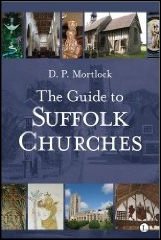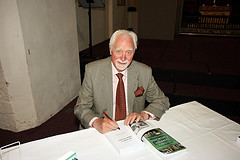| |
|
 |
|
When I first started
exploring the county of Suffolk ten years
ago, it was in the company of dead men.
The best of these men, Munro Cautley, had
travelled the same pathways as me a
quarter of a century before I was even
born, but still I found his help
invaluable. His post-war Suffolk
Churches and their Treasures was
still regarded as the definitive guide to
the county's churches. There was also
Nikolaus Pevsner, whose Buildings of
England series is rightly seen as
one of the great literary achievements of
the 20th Century. But Pevsner had been
ill-served in Suffolk: the 1975 revision
of his Suffolk volume was
perfunctory at best, and, apart from
noting the extensive redevelopment of
Ipswich, is little different to the 1961
original. Arthur Mee was amusing, but his
The Kings England: Suffolk had
been published before the Second World
War, and since then the county had
undergone radical changes. These dead men
were pleasant company, but again and
again I tipped up in remote parishes to
find the church converted into a house,
or surrounded by excrutiating suburbia,
or even completely vanished. It was like
using a map which was half a century out
of date. And then I
discovered DP 'Sam' Mortlock. In the late
1970s and 1980s, he had cut a three
volume swathe through the churches of
Norfolk in the company of Charles
Roberts, and he had then proceeded to do
the same for Suffolk, this time on his
own. The six volume Popular Guide
series was an anti-clockwise tour through
the two counties, and it got better as it
went along. Mortlock and Roberts had
started in Norwich and north-east
Norfolk, replicating the area covered by
the first of the two Pevsner volumes for
Norfolk, describing the churches in brief
details. But then they got into their
stride, and it had taken them two volumes
to visit the area covered by the second
volume, and fully three for Mortlock to
explore the county of Suffolk, which
Pevsner managed in a single, much smaller
volume. And Mortlock was just exploring
the churches, of course.
|
Discovering
Mortlock was a little like putting the lights on.
The three Suffolk guides, now updated and brought
together in a single lavish 600-page volume by
Lutterworth, were originally published by Acorn
Press, a small Cambridge-based publishing house,
and by the early years of the 21st Century they
were difficult to obtain, and still apparently
little-known. The books are organised
alphabetically by parish name, each entry being a
methodical guide to the exterior and then the
interior of the parish church. Mortlock had
originally explored Suffolk in three vertical
strips, covering the Western, Central and Eastern
parts of the county. What a joy it is to have
them republished together, in a single
alphabetical sequence, extensively revised and
updated.
The
beauty of Sam Mortlock is that he writes as an
enthusiast. While there is no doubt about his
expertise, or the completeness of each review, he is never formulaic; his
eloquent prose finds room for insignificant
details which he happens to find interesting,
alongside the expected naming of furnishings and
architectural features. Coming to a known church
with Mortlock is like seeing it for the first
time. Secondly, the articles are largely
accurate; you know you are in the presence of a
learned man who has walked these ways before you.
Most importantly of all, Mortlock has what I
think of as an Anglican sensibility. He knows the
true emotional value of the buildings he
describes. These three aspects of his work mean
that he is a more affable, knowledgeable and
enjoyable companion than Pevsner.
Compared
with Norfolk, the entries in Suffolk
are often lengthy, running perhaps to several
pages for even some of the lesser-known churches.
A typical Mortlock
description of a church begins with a tour of the
outside. He has the engaging manner of a
detective, piecing together the story of the
building from the available evidence, describing
the historical development and any idiosyncratic
features. Once inside, his eye ranges around the
fixtures and fittings, their age, provenance and
significance. He has a particular knowledge of
post-Reformation memorials and 19th century
glass, making him a useful counterpoint to
Cautley, who paid full attention to medieval
features, but usually ignored the rest. In almost
every church Mortlock finds something which you
would not otherwise notice. He muses on
inscriptions, sometimes allowing himself a quiet
chuckle and inviting us to join in. And yet, he
never loses the discipline of the investigator,
and rarely misses anything.
Mortlock is a handy
companion to any visit, but I like him better to
come home to, when I can read and understand what
I've seen, and what I've missed - oh, the
pleasure of knowing that there needs to be a
second visit! Best of all, his book is to be read
idly and at leisure, for compiling a wish-list of
visits, and making mental notes about things I'd
really like to see. Even though I've now visited
every Suffolk parish church, I still do this. It
is a form of church exploration in itself.
The old Suffolk volumes
were always better than the Norfolk ones, and the
new Guide to Suffolk Churches is
outstanding, even better than the revised volume
for Norfolk. This is partly because the revision
and updating has been much more rigorous than it
was for Norfolk. Special attention has been paid
to updating events since the 1989-92 publication
of the volumes of the first edition, and the
local Anglican Diocese has been extremely
helpful, allowing access to faculties for
extensions and refurbishments, and particularly
to details of millennium projects, many of which
were in stained glass. Sam spent more than a year
revisiting many of these in person. Because of
this, there is not much missing. All that seems
to have fallen through the gap between the two
editions is a handful of minor projects completed
before the new millennium - of these, probably
only the omission of Surinder Warboys' fabulous
1990s windows at Chillesford will raise the
eyebrow of any future explorer.
Unlike the volumes for
Norfolk, the first Suffolk books also contained
the modern churches as well, however
insiginficantly they might have been tucked away
in the suburbs of Ipswich or Lowestoft. They are
a feature of the new edition too, and,
ironically, this causes a slight skew of
emphasis, not least because you will not find any
of Suffolk's dozen or so outstanding earlier
non-conformist or Catholic churches here - Sam is
rigorously Anglican in his tastes. However, as a
bonus, that great Suffolk bell-ringing expert
George Pipe, a friend of Mr Morlock for many
years, has contributed details of all the
ringable bells in the county.
| Sam is now in his
mid-eighties, and although he looks a
good twenty years younger, he tells me
that the Norfolk and Suffolk volumes are
his 'swansong'. Although I think there is
plenty more to come from the pen of Mr
Mortlock - he is writing a history of the
Earl of Leicester's library, and there
are also rumours of a book about
almshouses - there is no doubt that these
two volumes will be his great legacy. I
said in my review of the Norfolk volume
that it was essential reading. I think
that the Suffolk volume is more important
than that. In the absence of any proper
revision of the 1961 Pevsner, it
remains the only complete and reliable
guide to the churches of Suffolk in
print. Even when Pevsner's revising
editor has completed his work, I believe
that Mortlock's Guide to Suffolk
Churches will remain the definitive
text on the subject for a half a century
or more to come.
|
|
 |
|
|
|

